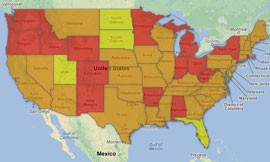Cronkite News has moved to a new home at cronkitenews.azpbs.org. Use this site to search archives from 2011 to May 2015. You can search the new site for current stories.
Report: Arizona teachers less likely to have high absenteeism
WASHINGTON – One in three Arizona teachers was absent for more than 10 days in the 2009-2010 school year, slightly better than the national rate of 36 percent, according to a recent report.
The author of “Teacher Absence as a Leading Indicator of Student Achievement” said Arizona’s 34.1 percent rate is likely due to the relatively high number of charter schools in the state and generally less-permissive policies in Western states.
“It has to do a lot with district policy,” said Raegen Miller, who wrote the report for the Center for American Progress. “There is variation in teacher absence behavior, within districts, within schools that have the same policies.
“The policy climate in Arizona is less permissive for absences,” Miller said. “Western states tend to have less generous privileges than Northeastern states.”
Miller, who has researched teacher absences for eight years, said his report looked at 56,837 schools across the country. He concedes that the 10-day figure is somewhat arbitrary and said the report is meant to spark further research on the topic of absences, their effect on student performance and policies to deal with it.
Joe Thomas, vice president of the Arizona Education Association, called the report “interesting” but said he does not believe it represents teachers fairly. Thomas, who is also a high school teacher in Mesa, said it uses “catchy numbers to grab attention.”
“I never heard of this being a problem in Arizona,” Thomas said.
But Scottsdale Unified School District Associate Superintendent Jeff Thomas – no relation to Joe Thomas – said his district did get complaints from parents in the past about teacher attendance and decided to take action.
In an effort to keep teachers at work, he said the district two years ago began combining incentives with punitive measures that range from docking pay to termination in the worst cases.
“We do it in Scottsdale, and there has been a slight reduction (in the absence rate),” he said.
“A consequence of absence without permission – they don’t get paid,” Jeff Thomas said. “It works.”
Miller said incentives are one possible way to address absences, that simply cutting teachers’ sick and personal days is not the solution. Joe Thomas agreed that offering teachers incentives to keep their absence rate low makes for good policy.
“You always need to have carrots and sticks,” Joe Thomas said. “Incentives at a local level are positive.”
But that policy should be made locally and not at the state level, he said.
“What works in Mesa might not work in Tuba City,” Joe Thomas said.
For charter school operators, policy decisions about teacher absences are easier.
“Our schools don’t have money for substitute teachers,” said Eileen Sigmund, executive director of the Arizona Charter Schools Association.
She said Miller’s finding that charter schools have lower absenteeism did not come as a surprise. When a charter school teacher is absent, his class becomes the responsibility of other teachers on staff, adding to their usual workload, Sigmund said.
“It disincentivizes our teachers from placing that added work on co-workers,” she said.
Sigmund added that charter school teachers do not get time off for professional development, since such training is typically scheduled on vacation days or when school is over for the day.
There are 535 charter schools in Arizona, serving an estimated 144,802 students.
Bureau of Labor Statistics spokesman Gary Steinberg said Miller’s 10-or-more-days threshold cannot be compared to other statistics for the U.S. workforce as a whole.
While the BLS keeps statistics for the percentage of U.S. workers who take a week off in a given week – about 3 percent of workers in 2011 – the 10 teacher absences in Miller’s report could be taken all at once or scattered over the year. The two data sets are not at all comparable, Steinberg said.
Even if they could be compared, Joe Thomas said it is unfair to put absenteeism for teaching up against other occupations, where workers have more flexibility to set their schedules.
“Other jobs can give one day off a week, different jobs require different procedures,” Joe Thomas said. “You have to be careful what you compare teachers to.”
He said teachers work 8 to 4 every day, with no time for private business like going to the bank or having an annual physical.
“These are not excuses,” Joe Thomas said. “This is a complex issue.”
But Jeff Thomas has no problem comparing one aspect of teacher absence to other professions.
“In mostly any other job, when workers are absent, productivity goes down,” he said. “And it’s the same premise for teaching: If teachers are absent, quality of instruction goes down.”
He said a lot can be done to improve teacher attendance without devaluing their work and without punitive measures.
Miller’s report suggests as much, saying everything from a minimum number of sick days for teachers to greater use of hand sanitizer can help cut absences.
“It’s overboard when we’re not empathetic about needs they have,” Jeff Thomas said. “They’re human.”







